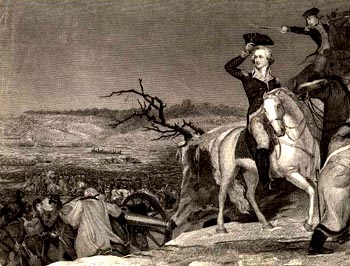|
FRESH STUFF DAILY |
|
|
||
|
|
||
|
|
||
|
SEE ALL SIGNED BOOKS by J. Dennis Robinson click here |
||
Page 2 of 4
"The Passage of the Delaware" Painter Thomas Sully was born in England, but grew up in South Carolina. He was scarcely a teenager when Prince Whipple died in Portsmouth, NH in 1796. By the time he came to paint the giant canvas (over 12 X 17 feet) of Washington at the Delaware River, Sully had become one of Philadelphia's leading portrait and figure painters. What Sully craved was to paint history. At this time, recreating authentic images of famous events was considered the highest calling of a portrait artist. His opportunity came from the government of North Carolina. Excited by victory against the British in 1812, every state wanted to honor Washington. North Carolina wanted two copies of the popular Gilbert Stuart likeness for the new capitol building. Sully underbid his competition, offering to copy the Stuart picture for $400 and include an original Washington image of his own for $600. He got the job, but due to a communications breakdown, in 1819 Sully painted a canvas too large for the state capitol. He chose instead to tour the painting, but it turned out not to draw great crowds and he sold it for $500. It has, since then, spent most of its life in Boston, either rolled up in storage, or on exhibit. It currently hangs in the Boston Museum of Fine Arts. In Sully's painting, Gen. Washington is on horseback, not standing in a wooden boat as later envisioned by Emanuel Leutze. Historical accuracy, as best it could be determined, was critical to Sully who exerted great effort to depict the precise details of the scene. He took pains to present Washington at his proper age, the "Durham" boats in the background, the precise dress and weaponry of soldiers. This makes his decision to include a single black trooper especially important. It is the closest the world will get, though imagined, to a portrait of a black Revolutionary hero. Philipp P. Fehl (Art Bulletin, Vol. VL, No. 4, December 1973) suggests that the African-American in Sully's painting may be Washington's own slave William Lee. Washington called him "my mulatto man" and provided for him in his will. Fehl says Sully may have drawn the portrait of Lee from another painting, but notes that the black figure in Sully's work is a different face, a "more ideal representation." Interestingly, Prince Whipple, unlike William Lee, was described by his contemporaries as "a large, well proportioned man, and of gentlemanly manners and deportment." But Sully would have had no way of knowing Whipple or his description. Historian Sidney Kaplan ("The Black Presence in the Era of the Revolution," National Portrait Gallery, 1975) supported the theory that Prince Whipple, indeed, is depicted in both paintings. Continue with PRINCE WHIPPLE Please visit these SeacoastNH.com ad partners.
News about Portsmouth from Fosters.com |
| Tuesday, April 23, 2024 |


|
Copyright ® 1996-2020 SeacoastNH.com. All rights reserved. Privacy Statement
Site maintained by ad-cetera graphics

 Stories
Stories



















